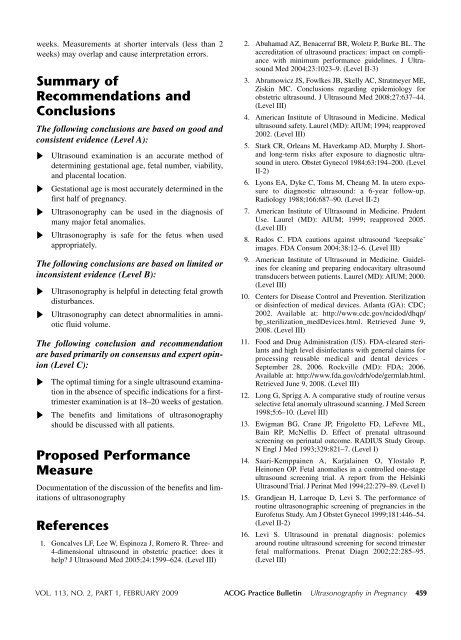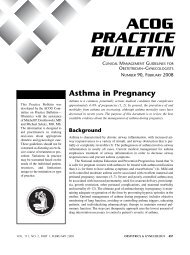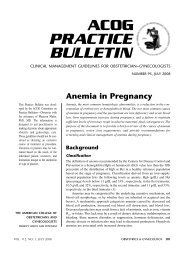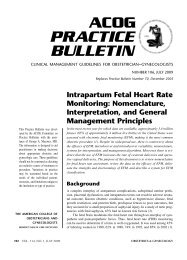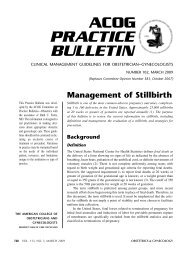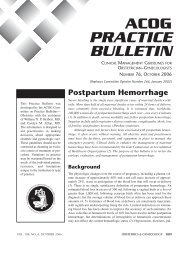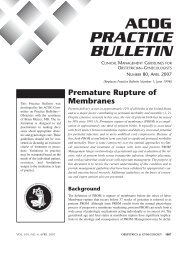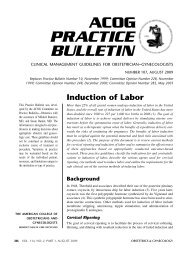ACOG Practice Bulletin No. 101
ACOG Practice Bulletin No. 101
ACOG Practice Bulletin No. 101
You also want an ePaper? Increase the reach of your titles
YUMPU automatically turns print PDFs into web optimized ePapers that Google loves.
weeks. Measurements at shorter intervals (less than 2<br />
weeks) may overlap and cause interpretation errors.<br />
Summary of<br />
Recommendations and<br />
Conclusions<br />
The following conclusions are based on good and<br />
consistent evidence (Level A):<br />
Ultrasound examination is an accurate method of<br />
determining gestational age, fetal number, viability,<br />
and placental location.<br />
Gestational age is most accurately determined in the<br />
first half of pregnancy.<br />
Ultrasonography can be used in the diagnosis of<br />
many major fetal anomalies.<br />
Ultrasonography is safe for the fetus when used<br />
appropriately.<br />
The following conclusions are based on limited or<br />
inconsistent evidence (Level B):<br />
Ultrasonography is helpful in detecting fetal growth<br />
disturbances.<br />
Ultrasonography can detect abnormalities in amniotic<br />
fluid volume.<br />
The following conclusion and recommendation<br />
are based primarily on consensus and expert opinion<br />
(Level C):<br />
The optimal timing for a single ultrasound examination<br />
in the absence of specific indications for a firsttrimester<br />
examination is at 18–20 weeks of gestation.<br />
The benefits and limitations of ultrasonography<br />
should be discussed with all patients.<br />
Proposed Performance<br />
Measure<br />
Documentation of the discussion of the benefits and limitations<br />
of ultrasonography<br />
References<br />
1. Goncalves LF, Lee W, Espinoza J, Romero R. Three- and<br />
4-dimensional ultrasound in obstetric practice: does it<br />
help J Ultrasound Med 2005;24:1599–624. (Level III)<br />
2. Abuhamad AZ, Benacerraf BR, Woletz P, Burke BL. The<br />
accreditation of ultrasound practices: impact on compliance<br />
with minimum performance guidelines. J Ultrasound<br />
Med 2004;23:1023–9. (Level II-3)<br />
3. Abramowicz JS, Fowlkes JB, Skelly AC, Stratmeyer ME,<br />
Ziskin MC. Conclusions regarding epidemiology for<br />
obstetric ultrasound. J Ultrasound Med 2008;27:637–44.<br />
(Level III)<br />
4. American Institute of Ultrasound in Medicine. Medical<br />
ultrasound safety. Laurel (MD): AIUM; 1994; reapproved<br />
2002. (Level III)<br />
5. Stark CR, Orleans M, Haverkamp AD, Murphy J. Shortand<br />
long-term risks after exposure to diagnostic ultrasound<br />
in utero. Obstet Gynecol 1984;63:194–200. (Level<br />
II-2)<br />
6. Lyons EA, Dyke C, Toms M, Cheang M. In utero exposure<br />
to diagnostic ultrasound: a 6-year follow-up.<br />
Radiology 1988;166:687–90. (Level II-2)<br />
7. American Institute of Ultrasound in Medicine. Prudent<br />
Use. Laurel (MD): AIUM; 1999; reapproved 2005.<br />
(Level III)<br />
8. Rados C. FDA cautions against ultrasound ‘keepsake’<br />
images. FDA Consum 2004;38:12–6. (Level III)<br />
9. American Institute of Ultrasound in Medicine. Guidelines<br />
for cleaning and preparing endocavitary ultrasound<br />
transducers between patients. Laurel (MD): AIUM; 2000.<br />
(Level III)<br />
10. Centers for Disease Control and Prevention. Sterilization<br />
or disinfection of medical devices. Atlanta (GA): CDC;<br />
2002. Available at: http://www.cdc.gov/ncidod/dhqp/<br />
bp_sterilization_medDevices.html. Retrieved June 9,<br />
2008. (Level III)<br />
11. Food and Drug Administration (US). FDA-cleared sterilants<br />
and high level disinfectants with general claims for<br />
processing reusable medical and dental devices -<br />
September 28, 2006. Rockville (MD): FDA; 2006.<br />
Available at: http://www.fda.gov/cdrh/ode/germlab.html.<br />
Retrieved June 9, 2008. (Level III)<br />
12. Long G, Sprigg A. A comparative study of routine versus<br />
selective fetal anomaly ultrasound scanning. J Med Screen<br />
1998;5:6–10. (Level III)<br />
13. Ewigman BG, Crane JP, Frigoletto FD, LeFevre ML,<br />
Bain RP, McNellis D. Effect of prenatal ultrasound<br />
screening on perinatal outcome. RADIUS Study Group.<br />
N Engl J Med 1993;329:821–7. (Level I)<br />
14. Saari-Kemppainen A, Karjalainen O, Ylostalo P,<br />
Heinonen OP. Fetal anomalies in a controlled one-stage<br />
ultrasound screening trial. A report from the Helsinki<br />
Ultrasound Trial. J Perinat Med 1994;22:279–89. (Level I)<br />
15. Grandjean H, Larroque D, Levi S. The performance of<br />
routine ultrasonographic screening of pregnancies in the<br />
Eurofetus Study. Am J Obstet Gynecol 1999;181:446–54.<br />
(Level II-2)<br />
16. Levi S. Ultrasound in prenatal diagnosis: polemics<br />
around routine ultrasound screening for second trimester<br />
fetal malformations. Prenat Diagn 2002;22:285–95.<br />
(Level III)<br />
VOL. 113, NO. 2, PART 1, FEBRUARY 2009 <strong>ACOG</strong> <strong>Practice</strong> <strong>Bulletin</strong> Ultrasonography in Pregnancy 459


